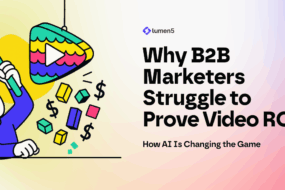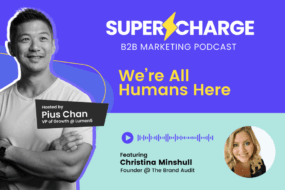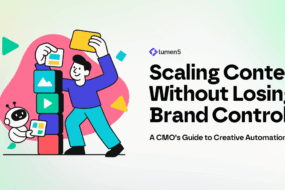
The most successful brands are preparing for 2026 with a renewed focus on speed, efficiency, and visibility. Marketing leaders are investing in smarter workflows and AI tools that help them do more with less. In this environment, time and cost efficiency have become growth drivers. Video, repurposed content, and consistent storytelling are the levers that move modern brands forward. Platforms like Lumen5 are emerging as essential allies, helping teams accelerate production and scale content without inflating budgets.
- Why Acting Now Matters
- Why 2026 Is About Building Momentum Early
- 1. Content Velocity Creates Competitive Advantage
- 2. Cost and Time Savings as Growth Levers
- 3. The Power of Content Repurposing
- 4. The New Buyer’s Journey Is Marketing-Led
- 5. Purpose and Authenticity as Growth Drivers
- 6. Measuring Speed and Impact
- The Cost of Waiting
- Building a Marketing Engine for 2026
Why Acting Now Matters
The brands that will win in 2026 are not waiting for the new year to begin their transformation. They are acting now, in Q4 2025, to build momentum before the calendar resets. The fourth quarter is no longer downtime for planning. It is the launchpad for the next growth cycle.
Marketing cycles are shorter than ever. Algorithms change quickly, audience expectations evolve, and visibility windows close fast. Brands that enter 2026 with active campaigns, proven content systems, and measurable insights will outpace those that start from zero in January. By building their operational rhythm now, leading teams are ensuring they hit the ground running when budgets refresh and competition intensifies.
Waiting until 2026 planning officially begins means losing a full quarter of momentum. That gap translates into missed opportunities, lower brand visibility, and slower lead generation in Q1. Momentum built in Q4 compounds, giving forward-thinking brands a significant advantage when the market resets.
Why 2026 Is About Building Momentum Early
The marketing landscape has changed dramatically. Buyers are more informed, and most of their journey happens before they ever speak to sales. In both B2B and B2C markets, marketing now leads the conversation, shaping perception, driving engagement, and building trust before a single demo or consultation.
This shift requires brands to stay visible across multiple touchpoints. Those who start early and maintain consistent communication will dominate attention and trust in 2026. The ability to produce high-quality content quickly and cost-effectively is now a key differentiator. Tools like Lumen5 empower marketing teams to meet these demands by automating video creation and simplifying content repurposing.
1. Content Velocity Creates Competitive Advantage
Marketing velocity, or the ability to create, publish, and adapt content rapidly, is becoming a defining factor of brand success. Companies that move faster learn faster. They test, iterate, and optimize while others are still waiting on approvals.
Across Lumen5’s enterprise customers, video production costs drop by up to 95%, and content velocity increases by 10–15x. That kind of efficiency changes how teams perform. It allows marketing organizations to maintain a steady rhythm of content while reallocating budget toward experimentation, media, and strategy.
Consider Siemens, which created more than 4,000 videos in just twelve months and achieved a 98% faster turnaround by equipping communicators worldwide with Lumen5’s tools. Swiss Re reported similar gains, producing 551 videos in one year with an average creation time of 30 minutes. The University of Georgia cut production time from two weeks to a single day after just one hour of onboarding, while Berkshire Hathaway HomeServices produced 500 videos in ten months, with each asset built in roughly six minutes.
In a landscape defined by attention scarcity, velocity becomes brand equity.
2. Cost and Time Savings as Growth Levers
Marketing budgets are under scrutiny, but expectations are higher than ever. Teams must find ways to create more content without proportionally increasing spend. This has made efficiency and automation central to success.
AI-powered platforms like Lumen5 help teams reduce costs across several areas:
- Lower production costs: Traditional video creation can take days or weeks and require designers, editors, and producers. AI automation reduces that time to hours, sometimes minutes.
- Reduced dependency on agencies: Internal teams can now create professional-quality content without outsourcing.
- Faster go-to-market: When production time drops, campaigns launch sooner, driving earlier results.
These efficiencies translate into measurable savings and greater agility. For example, Best Western Hotels produced more than 480 videos in a single year at 94% lower costs than agency production, achieving 97% faster creation cycles. CMS shifted from producing fewer than ten videos per year to nearly one per day by simplifying its workflow. DNV cut video creation time to a quarter of what it was before and saw improved engagement and click-through rates.
3. The Power of Content Repurposing
The best marketing teams do not simply create new content. They maximize the potential of what they already have. Repurposing allows brands to extend the lifespan of high-performing assets while tailoring messages for new audiences or channels.
A single thought leadership article can become a series of social videos. A webinar can become a collection of short clips that highlight key insights. A research report can evolve into a narrative-driven explainer. This approach keeps content pipelines full and ensures your message stays consistent across platforms.
Lumen5 plays a major role in this process. It transforms written or recorded material into visually engaging videos at scale, making it easier for teams to distribute content where audiences spend time, such as LinkedIn, YouTube, and internal enablement hubs. The savings in cost and time are significant, but the real value lies in the creative flexibility it provides.
Companies like Emerson turned complex technical collateral into short, digestible videos that modernized their customer experience. GHX replaced sporadic outsourced assets with consistent in-house production, improving agility and engagement. NC State University repurposed academic research into simple, shareable videos, increasing views by 118%, comments by 135%, and shares by 145%. Meanwhile, Mondadori tripled average video views year over year and doubled engagement across its digital channels.
4. The New Buyer’s Journey Is Marketing-Led
Buyers now conduct most of their research before engaging with sales. Studies show that more than 70% of a buyer’s decision-making process happens online, driven by digital content. Marketing is no longer a support function; it is the primary engine of growth.
High-performing marketing teams are building ecosystems that educate, engage, and nurture buyers through self-service experiences. Video content is particularly effective in this model because it helps brands explain complex ideas simply and builds credibility quickly. When prospects encounter consistent, high-quality video content across channels, they begin to view the brand as an authority before any direct conversation.
Cisco cut content turnaround from days to minutes, increasing average engagement per post by 23% when using video instead of static imagery. Siemens empowered hundreds of communicators worldwide to produce localized, timely video content for events and product launches, delivering over 4,000 assets in a single year. These examples highlight how marketing-led organizations use video to fuel awareness and authority throughout the buyer’s journey.
5. Purpose and Authenticity as Growth Drivers
Beyond efficiency, leading brands are aligning content strategies with purpose and authenticity. Audiences gravitate toward companies that reflect their values. Storytelling is most effective when it feels human, consistent, and relevant to the audience’s world.
Video is a powerful medium for this type of storytelling. It conveys emotion, tone, and authenticity in ways that text cannot. Marketing leaders are building video-first strategies to communicate purpose across all channels, not as a single campaign but as an ongoing dialogue with their audiences.
6. Measuring Speed and Impact
Forward-thinking organizations are redefining success metrics. Instead of measuring only reach or clicks, they focus on engagement quality, brand recall, and conversion from marketing-led experiences.
When content production becomes faster and more cost-efficient, it opens the door to experimentation. Teams can test new ideas, formats, and narratives without heavy investment. AI-powered tools like Lumen5 make this cycle sustainable. They enable teams to learn quickly, refine strategies, and allocate resources based on real performance data.
The Cost of Waiting
Brands that wait until January to begin 2026 planning will start from zero. While competitors are already running content, testing campaigns, and capturing audience attention, late starters will spend the first quarter building infrastructure instead of generating impact. That lost time compounds quickly.
In practical terms, three months of missed momentum can mean a 25% reduction in annual campaign output and delayed pipeline generation. Q4 2025 is the time to build systems, refine processes, and establish content velocity. The earlier you start, the more leverage you carry into 2026.
Customers like Siemens, Swiss Re, Best Western, and the University of Georgia saw transformative results precisely because they started early. Siemens achieved a 98% faster turnaround, Swiss Re produced hundreds of videos in months, and Best Western cut creation costs by 94%. Each of these organizations built momentum before their next planning cycle, proving that early action compounds into competitive advantage.
Building a Marketing Engine for 2026
For brands preparing to hit the ground running in 2026, the path forward is clear: speed, consistency, and intelligent automation. The ability to create and repurpose content quickly has become a defining competitive edge. Video is the medium that ties it all together, combining storytelling, trust, and visibility.
Lumen5 helps marketing organizations scale content creation, reduce costs, and build momentum. Across its enterprise customer base, average video production costs have dropped by up to 95%, while content output has increased by 10–15x. These gains redefine what marketing teams can achieve with the same resources.
The brands that win in 2026 will be those that act now. By moving early, they create the systems and momentum that carry them into the new year ready to grow. The future belongs to marketing teams that understand one truth: success in 2026 starts in Q4 2025.





